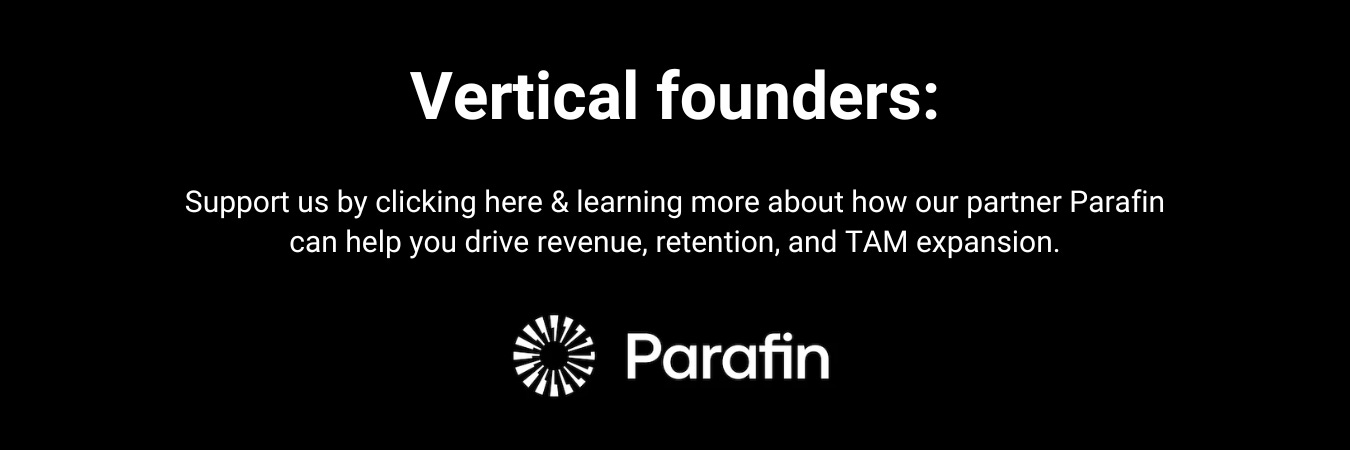As our latest data makes clear, the biggest category—by far—in Vertical AI is healthcare. Sometimes, the business model is quite familiar: clinics buying subscriptions. Just as often, the byzantine nature of the modern healthcare industry requires AI founders to approach monetization in creative and unintuitive ways.
In this week’s show, we get concrete about the future of healthcare age of AI: how money flows line up with incentives, how the public and private sectors collide, and how this enormous opportunity is only in its first inning.
Our Vertical Titan today is Mike Kopko, Founder & CEO of Pearl Health. From his formative years at Bridgewater, to seeing Oscar though to IPO, to building Pearl Health, Mike knows his space cold. He lays out his vision for leveraging AI to power value-based care. It’s an extraordinary story of a network-driven software platform that touches every stakeholder in his vertical, all while navigating the complexity of health outcomes, physician partnership, government programs, and insurance payouts.
Stick around for Mike’s earned insights on the future of healthcare AI… and how agentic voice / text will actually change care delivery.
I) Vertical Market Pulse
The reality of AI adoption in the enterprise
Vertical AI Playbook | Kyle Harrison & Etienne Segal @ Contrary Research
We discuss research covered by Contrary claiming that 42% of enterprise AI initiatives were discontinued in 2024. Our take: treat surveys with skepticism. What enterprises say and do when it comes to cutting-edge tech adoption is influenced by marketing pressures. But we should accept we’re in a healthy test‑and‑learn phase. Many enterprises—especially in non-tech-forward vertical markets—don’t have the resources to implement AI yet in a truly impactful way. Vertical founders should benefit from this: sell provable time‑to‑value and measured ROI for discrete use cases vs. “AI.” Also, considering forward-deployed resources. We’re in a moment where enterprises want to adopt AI… and may be willing to pay for help to operationalize.
AI-powered care navigation startups approach maturity
Thyme Care raises ~$97M | Jessica Hagan @ Mobi Health News
Oncology is the #1 cost driver for US health plans. Thyme Care offers AI‑assisted care navigation that coordinates referrals, follow‑ups, labs, and communication—aiming to unlock better patient experience and cost savings along the way. Care navigation startups—which exist across many specialities—generate revenue via both traditional PMPM and risk‑sharing. A big challenge they face is integration across EHRs and stakeholders. Thyme is arguably not AI native. It will be interested to see if “agentic care navigation” yields savings and whether next-gen startups can approach it differently.
The AI infrastructure spending boom: are we in a bubble?
Deus Ex CapEx | Euclid Ventures Team @ Euclid Insights
We discuss Euclid’s deep dive on the data center boom and its impact on AI pricing. Analysts estimates suggest that in 1H 2025, AI data center spending contributed more to GDP growth than all US consumer spending combined—marking a historic first. Another remarkable statistic: spending on data center construction, excluding the cost of all the technology inside the data center, is expected to surpass spending on office building construction this year. Hundreds of billions in CapEx spend presumably must be recouped in net‑new AI revenue. As for AI pricing: Euclid expects per‑token prices to continue to drop for stable model families, but not for frontier reasoning models (as more complex queries raise tokens / query substantially). At least until we see significant unlocks around model efficiency.
II) Vertical Titan
Mike Kopko — Founder / CEO @ Pearl Health
The backstory.
Mike grew up as an operator—Bridgewater during the ’08 crisis, then seven‑plus years helping take Oscar public. Pearl’s mission: help physicians deliver anticipatory, outcomes‑oriented care to seniors (Medicare, 65+) and participate in the savings created. Today that spans ~6,000 physicians and ~250,000 seniors, with reductions in hospitalizations, ER visits, mortality, and cost of care.
Payments‑first wedge.
Pearl started by paying providers—on time. Before elegant UX, the “product” was a reliable monthly wire and clean reconciliation. That oxygen (Mike’s word) bought trust and distribution; only then did Pearl layer in guidance on a few high‑leverage behaviors (e.g., timely post‑discharge outreach). Early on, Pearl even fronted advances/bonuses where it had strong conviction the behaviors would yield savings.
How Pearl gets paid.
Two streams: (1) software fees (smaller today), and (2) share of savings. Example math (simplified): if an avoided hospitalization averages ~$30k, the government/payer keeps ~50%; Pearl and the physician split the rest—about $7.5k each on a single avoided event—on top of normal visit economics. Pearl targets lowering total cost of care by 3–5% across a multibillion‑dollar spend base.
Operating leverage without a bloated services org.
Competitors staffed large contact centers; Pearl bet the practice would do 5–10 targeted calls/day if the economics and prompts were clear. Now, agentic voice and text are arriving to automate that outreach, scheduling, transport coordination, and follow‑ups—driving scale without flipping into a services company.
Why not “just sell software”?
Because the budget lives in value‑based programs (REACH, MSSP) where outcomes matter. Pearl’s model wires analytics → provider actions → measurable events (e.g., lower readmits) → financial reconciliation. SaaS alone misses the upside and the alignment.
Measuring proof of impact in healthcare AI.
Start with pragmatic evidence: compare cohorts that follow Pearl’s guidance vs. those that don’t; track post‑discharge contact → timely PCP visit → reduced readmissions. JAMA‑grade RCTs may follow, but business validation already shows up when the government tallies year‑end savings against the budget.
Go‑to‑market complexity + Pearl’s evolution.
Pearl began with independent PCP groups (the “mom‑and‑pops”), then moved up to leading hospital systems. Of ~400k U.S. PCPs (~300k eligible for these programs), Pearl works with ~6k today. Expect consolidation: sub-scale practices can’t stand up data acquisition, prediction, ops sequencing, and financial reconciliation alone.
The hardest part.
A data & prediction company (claims, EHR, external signals).
A change‑management engine inside busy practices (behavioral follow‑through).
A finance shop that reconciles outcomes to dollars under government programs.
Memorable lines from Mike
“The oxygen in the room is payments.”
“We get paid basically by reducing bad events.”
“Drop your politics at the door. Tell me where the puck is going on a policy level.”
III) Vertical Playbook
Healthcare AI for Clinicians
Why it works
Acute events have outsize cost; small, repeatable interventions (post‑discharge call, 7‑day follow‑up) move hard outcomes that payers reward.
Aligning dollars up front (stipends, monthly wires, micro‑bonuses) earns the cultural permission to change workflows.
AI shines in non‑clinical logistics—contact, scheduling, transport, documentation—where speed and standardization beat heroics.
Proof loops (adherers vs. non‑adherers, near‑real‑time dashboards) can validate impact well before a peer‑reviewed study.
Payers will co‑fund what reliably lowers total cost; clear reporting and clean payment ops reduce friction.
How to run it (Pearl‑inspired blueprint)
Lead with dollars: set up reliable monthly payments or micro‑incentives so clinics feel the alignment on day one.
Pick 3–5 high‑leverage moves: e.g., discharge calls within 48 hours, 7‑day PCP follow‑ups, outreach to predicted high‑risk patients.
Make tasks tiny: ask for “five to ten calls per day” per site—wins accrue via consistency, not heroics.
Instrument the loop: track show rates, time‑to‑appointment, re‑admissions; compare adherers vs. non‑adherers and publish the gap.
Stand up agentic contact: use voice/SMS agents to trigger, schedule, and confirm follow‑ups; escalate edge cases to humans.
Meet payers where they are: propose clear performance terms (e.g., readmissions, ED visits), plus PMPM software where appropriate; commit to on‑time payments to providers.
Tighten documentation: help clinics capture accurate risk/comorbidity data so budgets/benchmarks reflect reality.
Min‑integration posture: don’t rip out the EHR; deliver a “single pane” that pushes prioritized tasks into existing workflows.
Front advances only when you’re sure: paying early buys trust, but the model must quickly prove out or it will sink you.
Expand care access fast: use tele‑specialty consults to compress wait times for cardiology/oncology follow‑ups.
Founder litmus tests
Do we know exactly who pays us and for what outcome, and can we explain it in one sentence?
Can our AI‑enabled interventions show leading indicators within a quarter (e.g., faster follow‑ups) even if full savings reconcile annually?
Can our clinic users realistically do “five to ten” extra outreach touches a day with our tooling?
If a payer is late, can we still pay providers on time without breaking our cash model?
Are we augmenting clinicians (contact/logistics/intel) rather than promising to replace them?
What we debated on‑air
Adoption vs. fatigue: big promises vs. retention reality in enterprise AI.
Navigation platforms’ lock‑in vs. integration headache across EHRs and systems.
Infra boom: cheaper tokens vs. more expensive reasoning tasks; don’t underwrite on outdated pricing curves.
Operate care yourself vs. power the incumbents; service‑heavy vs. technology‑leveraged scale.
Next week on Verticals
Tune in next week for a masterclass in Vertical GTM with Kyle Norton, CRO at Owner.
If you’re building in Vertical AI (or considering it) and want a sounding board, the Euclid Ventures team would love to hear from you. DM us here on Substack or ping us on LinkedIn.











